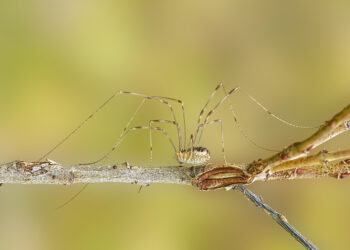
Life was already billions of years old before the Cambrian explosion that occurred roughly 540 million years or so ago. For all the time prior to this unprecedented surge in diversity and complexity, life was mostly relegated to simple, single-celled organisms. But then in the blink of an eye on a geological timescale, the first major animal phyla appeared, including arthropods, mollusks, echinoderms, and early vertebrates.
This was a period of intense evolutionary experimentation. Strange and wacky creatures struggled to survive, and competition was fierce. As the first animals evolved, some of them quickly became predators.
Among the odd critters living in these ancient seas was Opabinia, which had five eyes and an elephant trunk–like appendage. Meanwhile, Hallucigenia looked like a prickly worm with legs.
Now, scientists have revisited one of these oddballs, a 500-million-year-old species shaped like a taco called Odaraia alata. In a new study, researchers have described how they think the creature ate, with important implications for the evolution of hymenocarines, the ancestors of ancestors to shrimp, centipedes and crabs.
Revisiting an Ancient Fossil

Odaraia was discovered in the Burgess Shale over a century ago and described in the 1980s. However, many questions remained. Did it have mandibles? What did it eat? How did it capture its prey?
Alejandro Izquierdo-López, the lead author of the study and a Ph.D. student at the University of Toronto, aimed to answer these questions. His team of paleontologists examined about 150 of the 7-to-8-inch-long fossils using advanced imaging techniques unavailable in the 1980s. This approach significantly increased their chances of finding crucial features.
“The head shield of Odaraia envelops practically half of its body, including its legs, almost as if it were encased in a tube. Previous researchers had suggested this shape would have allowed Odaraia to gather its prey, but the capturing mechanism had eluded us, until now,” said Izquierdo-López.
Previous studies on Odaraia relied on about 20 samples. Lopez’s team had access to many more specimens, improving the odds of finding well-preserved mandibles. Despite this, only a few specimens showed the mandibles, hidden by the creature’s large head and the rock in which it was entombed. The animal had 30 pairs of legs and was covered in countless spikes, with its body enclosed by a ‘taco’ shell.
Using cross-polarized photography and microscopy, the researchers could ‘flatten’ the fossil’s appearance, revealing features otherwise obscured by the rock’s texture. This technique allowed them to observe the mandibles more clearly.
Mandibles and Modern Lifeforms
Seeing the mandibles and other details, the researchers gained a better understanding of Odaraia’s hunting methods. They hypothesize that it swam upside down, using its carapace to funnel water, spotted prey with its large eyes, entangled food with its spiny legs, and then used its mandibles to chew. Odaraia likely used its folds like two sides of a tortilla to create a funnel underwater.
The anatomical evidence suggests Odaraia and its relatives were likely suspension feeders, capturing particles or prey from the water column. The discovery of a trident-shaped tooth behind the mandible offers additional clues about Odaraia’s place in the evolutionary tree, suggesting its relation to modern arthropods.
Odaraia’s mandibles must have given it a significant competitive edge over other organisms. They would allow it to break larger chunks of food into pieces, providing access to new types of calories. In time, animals with mandibles would become Earth’s most diverse group of animals.
This research places Odaraia within the broader context of arthropod evolution. Arthropods, a group that includes insects, spiders, and crustaceans, number around a million species today. By identifying features like mandibles and the trident tooth, scientists can better understand how these ancient creatures relate to their modern descendants.
The findings appeared in the Proceedings of the Royal Society B.






